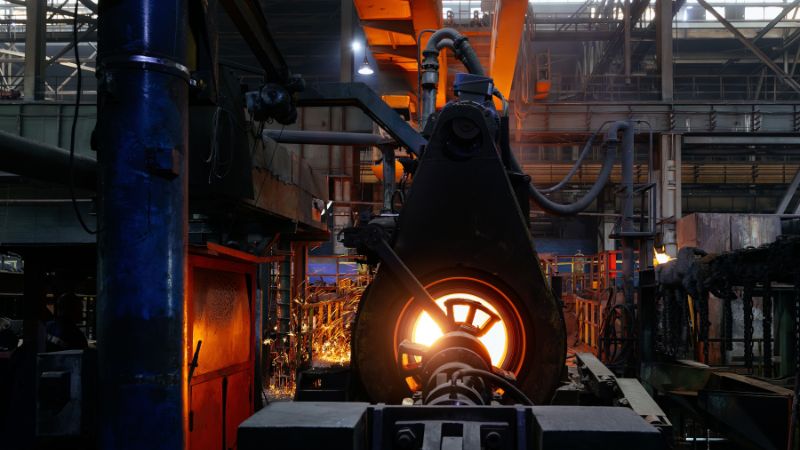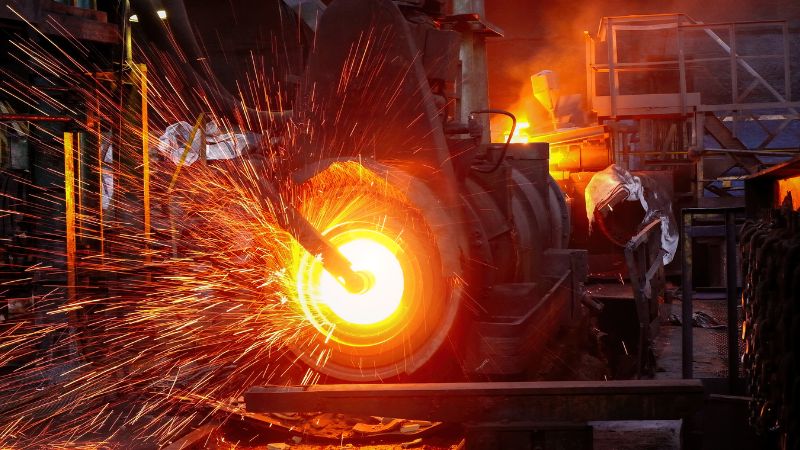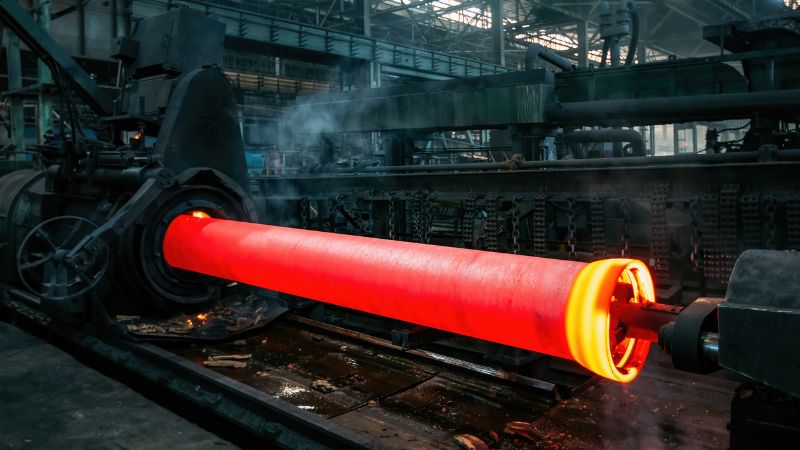Centrifugal die casting is a unique casting process that uses spinning molds to create strong, precise metal parts. You can use centrifugal casting to make items like pipes, rings, or cylinder liners with fewer defects and better strength than other methods.
If you want to understand how this process works and why it is trusted for important industrial jobs, you are in the right place. Learning about centrifugal die casting can help you decide if it is the best option for your next project.
Fundamentals of Centrifugal Die Casting
Centrifugal die casting uses spinning force to create solid, round metal parts. This casting technique helps control how molten metal fills the mould and removes trapped gases for a cleaner product.

Definition and Principles
Centrifugal casting process is comprised of a set of procedures where molten metal is poured into a spinning mould cavity. The mould spins at high speed in a centrifuge. The centrifugal force then pushes the metal against the inside walls of the mould.
This method is best for making parts with rotational symmetry, such as pipes, rings, and other hollow cylindrical components. It relies on the force from spinning, not gravity, to move the metal and fill the shape. Spin casting and rotocasting are other names used for similar methods.
The mould can spin either horizontally or vertically. The basic idea is that faster spinning gives more force and helps create dense, high-quality castings with few air pockets.
Key Components and Materials
Centrifugal casting machines, also called centrifuges, have a strong, round mould cavity set on a shaft. As the mould spins, you pour molten metal or alloys into it. The spinning spreads the metal along the mould walls.
Common metals for centrifugal die casting include cast iron, steel, copper, aluminum, stainless steel, and nickel-based alloys. Plastic materials like ABS can be used for small or non-metal parts, but metals are most common.
Main components include:
- Mould cavity (steel or sand)
- Core (used for hollow parts)
- Spin casting machine
The way you set up the machine changes depending on the size and shape you need to make. The mould material needs to withstand high temperatures and spinning forces.
Advantages and Limitation
Centrifugal casting offers several benefits. The spinning action removes trapped gases and impurities, resulting in stronger, cleaner castings. Parts made this way are dense and have a fine grain structure. This casting method is perfect for seamless pipes, bushings, and rings.
Advantages:
- Little or no need for extra finishing
- Makes round parts with no seams
- Works well for many metals and alloys
Limitations:
- Only useful for shapes with rotational symmetry
- Not good for complex or detailed parts
- Special tools and machines are required
- The process can sometimes leave slight variations in wall thickness
This technique is mainly chosen when you need strong, round, and durable metal parts.
Centrifugal Die Casting Process
In centrifugal die casting, you use a spinning mold to shape molten metal. Each step in the process affects the quality and strength of the finished part.

Mold Preparation and Setup
First, you need to prepare the mold, usually made from steel or cast iron. Special coatings are applied to the mold surface to help with metal flow and make removal easier. The mold is then mounted on a spinning machine.
If the part has a hole or hollow center, you insert a core. The core creates the desired internal shape and must fit tightly in place. After setting up the core, you close the mold and align it to make sure the cavity is well centered on the axis of rotation.
Proper mold setup is essential. Errors can cause poor material distribution, uneven wall thickness, or other defects. Careful inspection of the cavity, venting, and locks ensures better casting results.
Pouring of Molten Metal
Molten metal is melted in a furnace and transferred to a pouring ladle. The metal is then poured carefully into a pouring basin connected to the spinning mold. The pouring must be quick but steady to reduce oxidation and air entrapment.
The spinning action has usually begun before pouring starts. As you pour, centrifugal force moves the molten metal toward the mold walls, quickly filling the cavity.
Good pouring technique helps avoid air pockets and defects. The temperature and speed during pouring matter because they affect how the metal flows and solidifies.
Spinning and Solidification
As the mold spins, centrifugal force forces the molten metal outward. This creates a denser and more uniform part, especially at the outer surfaces. The force can reach several times the force of gravity depending on speed and part size.
Solidification begins at the mold wall and moves inward. This directional solidification helps push impurities and gases toward the inner surface, making the outer structure stronger and less porous.
The speed of spinning and cooling rate control the grain structure. Adjusting these factors improves the quality and reduces unwanted defects, such as shrinkage or bubbles near the outer wall.
Key points during this stage:
- High spinning speeds = denser metal
- Directional solidification removes impurities from outer layers
- Careful temperature control improves properties
Cooling and Removal
After all the metal has solidified, you stop spinning and let the casting cool further. You can speed up cooling with air or water, but controlled cooling is preferred to prevent cracks. Measurement tools may monitor the cooling process to ensure the part stays within tolerances.
Once the part is fully cool, you open the mold and remove the casting. If a core was used, you remove it now; sometimes, special tools are needed if the core is tightly fitted.
The casting then goes through finishing operations. This includes trimming extra metal formed at mold joints and removing small imperfections to meet your product’s final shape and surface requirements. Proper removal and finishing ensure the final part meets quality and dimensional standards.
Types of Centrifugal Die Casting
You can choose from several types of centrifugal die casting methods. The differences between these methods affect the shapes and properties of the final parts.
Horizontal Centrifugal Die Casting
Horizontal centrifugal casting uses a rotating mold that spins sideways, with its axis in a horizontal position. Molten metal is poured into one side of the mold while it is spinning. This is commonly used to make tubes, cylinders, and long pipes. Large-scale production lines often use this method because it can quickly make parts with uniform walls and high strength. The finished surfaces are usually smooth, which reduces the amount of machining needed later.
Horizontal systems work best for objects where the length is much greater than the diameter. The process can be automated for higher output, which also reduces labor costs.
Vertical Centrifugal Die Casting
Vertical centrifugal casting uses a mold that spins upright, with its axis in a vertical position. Metal is poured directly into the center axis of the spinning mold, and pushed outward to form the part. This technique is ideal for producing rings, bushings, and smaller, disk-like parts. The vertical setup allows for precise control over the thickness of the walls. It also makes it easier to remove unwanted impurities, as they tend to settle closer to the center, away from the finished product.
Vertical casting is often chosen for smaller or symmetrical parts where a round shape is needed. It is especially helpful when tight tolerances are required.
Properties and Quality of Centrifugal Die Castings
Centrifugal die casting produces parts with dense, uniform properties that are useful for many demanding applications. The process improves the internal structure, mechanical strength, and consistency of the finished components.

Material Soundness and Structure
Centrifugal die castings offer high material soundness. As molten metal is spun against the mold wall, impurities and gas bubbles move toward the inside surface. This often results in a part with very low internal porosity.
You can expect a uniform grain structure or even a fine-grained structure near the outer surface. These features make the casting less likely to have hidden defects.
Close control over the cooling rate increases density and creates a part with more reliable properties. The surface finish along the mold wall is usually smoother and needs less finishing work.
Mechanical Properties and Durability
Parts made by centrifugal die casting usually have improved mechanical properties when compared to standard castings. High density and reduced porosity help boost both strength and fatigue resistance.
These castings can handle repeated stress and are less likely to crack or fail over time. That is why you often see them used in high-reliability applications such as aerospace, pumps, and pressure vessels.
Since the structure is uniform and fine-grained, the parts tend to have good wear resistance. This adds to their durability and makes them last longer, even in tough environments.
Concentricity and Wall Thickness
Centrifugal die casting is known for excellent concentricity. The way the metal is forced against the spinning mold means that wall thickness is even and consistent all around the part.
You can expect tighter tolerance on wall thickness than with many other methods. A simple chart shows typical benefits:
| Feature | Centrifugal Die Casting | Other Castings |
|---|---|---|
| Concentricity | High | Moderate/Low |
| Wall Thickness | Even | Can Vary |
| Density | High | Lower (Variable) |
Smooth and regular inner and outer surfaces reduce the need for extra machining. This not only saves time but also keeps the final part more true to its intended shape.
Applications of Centrifugal Die Casting
Centrifugal die casting is used in many industries. You often see it used to make cylinder liners for engines, especially in cars and trucks. This method helps create strong and smooth parts that last longer.
You can also find this process used for making metal pipes and cast iron pipes. It is helpful for making long tubular parts like pipes and thin-walled cylinders. These parts have even walls and few defects.
Here are some common products made this way:
| Product | Industry |
|---|---|
| Cylinder liners | Automotive, Military |
| Metal pipes | Construction, Oil & Gas |
| Bearings | Machinery, Transport |
| Railway carriage wheels | Railways |
| Flywheels | Automotive, Industry |
| Hydro wear rings | Energy |
| Jet engine compressor cases | Aerospace, Military |
| Telescope mirrors | Astronomy |
In the aerospace field, you can find parts like jet engine compressor cases made by centrifugal die casting. These parts need to be very precise and strong.
This method also supports military applications. Items like bearings and specific engine parts are often made this way for their durability.
Centrifugal casting works well for prototyping tubular products, especially when you need complex shapes.
Frequently Asked Questions
How does semi-centrifugal casting differ from true centrifugal casting?
In semi-centrifugal casting, the mold is filled only partly with molten metal, and the process is used mainly for parts with a central core, like wheels. The metal is forced outward by spinning, but some parts may be shaped using a core.
In true centrifugal casting, the mold rotates around its own axis and is filled completely. This forms hollow, round parts such as pipes or tubes without using a central core.
What factors determine the selection of centrifugal casting over other casting techniques?
If you need products with high strength and fewer defects, centrifugal casting is often chosen. This method is ideal when making round, hollow parts like pipes, bushings, or rings.
You might pick centrifugal casting for better control over the inner and outer structure of the metal. It can also reduce impurities and gas pockets in the finished item.
